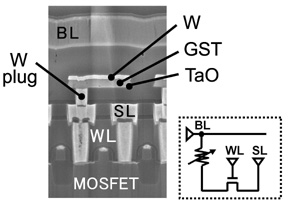IM Flash pre-announced “3D XPoint”(TM) memory for release later this year, and lack of details has led to widespread confusion regarding what it is. EETimes has reported that, “Chalcogenide material and an Ovonyx switch are magic parts of this technology with the original work starting back in the 1960’s,” said Guy Blalock, co-CEO of IM Flash at the 2016 Industry Strategy Symposium hosted by the SEMI trade group. However, contradicting industry terminology conventions, in another article EETimes reported that a spokesperson for Intel has said that, “3D XPoint should not be described as ReRAM.”
First promoted by the master of materials solutions-looking-for-problems Sanford Ovshinsky under the name “Ovonic” trademark, chalcogenide materials form glassy structures with meta-stable properties. With proper application of heat and electrical current, chalcogenides can be made to switch between low-resistivity crystalline and high-resistivity amorphous phases to create Phase-Change Memory (PCM) arrays in silicon circuit architectures. Chalcogenides can also function as the matrix for the diffusion of silver ions in a cross-point device architecture to create a digital “Resistive RAM” (or “ReRAM” or “RRAM”), or create an analog memristor for neuromorphic applications as explored by Prof. Kris Campbell of Boise State in collaboration with Knowm.

The Figure shows a schematic cross-section of a typical PCM cell. From a scientific perspective, we could say that any memory cell that relies upon a change in material phase to encode digital data should be termed a PCM. However, due to the history of this specific type of PCM device being the only architecture explored for decades (and commercialized for limited niche sub-markets), and due to the fundamentally different circuit architectures, it is reasonable to categorically deny that any cross-point device is a “PCM.”
However, any cross-point memory device based on a resistance change has to be a ReRAM regardless of the switching phenomenon: phase-change, filament-growth, ion-diffusion, etc. So we could say that this new chip uses PCM material in a ReRAM device.
—E.K.


